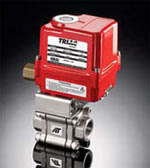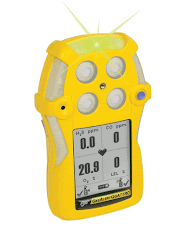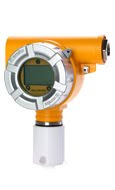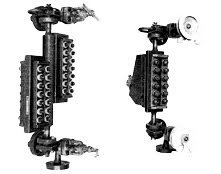When this article was written Lori L. McPherson, B.S. Chem E., was the analytical Specialist for Georg Fischer, Inc., Tustin, California.
The Conductivity Measurement
The conductivity measurement is literally a measure ment of of the solution's ability to conduct electricity. It is directly affected by the number of disolved ions in the solution. As the number of disolved ions increases, the ability to conduct electricity also increases. The measurement Value is generally considered to be a measurement of the actual number of ions contained in the sample, while in fact, this is only inferred.
The conductivuty measurement measurement unit is the inverse of the resistivity measurement. Resistivity measures the solution's ability to resist electrical current flow.This is measured in Ohm*cm. Therefore, conductivity mhos/cm, with mhos being defined as Ohms-1. This unit has been renamed by the international standards organization to be Siemen (S). However, both mhos/cm and S/cm are considered correct. In clean water (surface water, well water, etc.), the order of magnitude is in the range of 10-6 S/cm or uS/cm. ( us/cm = micro seimens).
The Affect of Temperature on Conductivity
The solution's ability to conduct electricity is related to the concentrationnand specific conductivity of the ions in the solution, and the temperature of the solution. Increased temperature provides increased activity or ionic movement that enables more electricity to be carried through the solution from one electrode to another.
In order to better correlate the electrical conductivity to the concentration of ions, the affect of temperature on the solutions ability to conduct electricity is subtracted from the actual conductivity. For example, a solution at 25 deg 'C' may conduct 200 uS. This same solution at 35 deg 'C' would conduct 240 uS. Since the primary purpose of the measurement is to correlate to the purity of the solution, the affect of temperature is subtracted (compensated), with a displayed, compensated value shown at 200 uS. This provides a means of standardizing the conductivity reading to a concentrationof ions at 25 deg 'C'.
Applications with Coefficients Different from Water
Many solutions other than water are effectively controlled using conductivity. Some of these include offset printing fountain solutions, water soluble lubricants used in metal machining and quenching solutions. many of these solutions have been tested to determine their temperature coefficients, and have been found to have coefficients significantly different than the 2.0 perecnt per degree celcius used for water solutions. If the coefficient used is incorrect, when the temperature of the solutions change, the conductivity value will be seen to change. However, in reality, the concentration in the solution remains the same.
Other solutions, such as acids or bases, can also have temperature coefficients significantly different than that of water. In many cases, each concentration range of a solution will have it's own temperature coefficient. For example, 10 percent sulfuric acid will have a muuch diufferent temperature coefficient than 50 percent, and those values will be different than sulfuric acid at 90 percent. To maintain the highest level of accuracy across temperature changes, it is recommended to check the temperature response of the solution, and program the instrument accordingly.
Applications that Should Not be Temperature Compensated
In some applications, the measurement of the true or actual electrical conductivity is important, without any standardization back to the conductivity level at 25 deg. 'C'. One example of this type of application is the salt solution used to shock poultry prior to processing. The salt content of this solution is monitored using conductivity, to ensure that it can carry sufficient current to effectively stun the chicken. In this case, the temperature compensation program should be deactivated (generally by introducing a coefficient of 0.0 per degree celcius). This activity guarantee that thsi measurement is a true measurement of the electrical current the solution will pass, and the process will operate as needed.
A second example is the reionization of pure water to prevent carona discharge across high pressure nozzles.In the semiconductor industry, the water used in rinsing wafers must be free of any impurities. In thuis state, the water generally has a resistivity associated with it of 18.3 Mega Ohms. Unfortunately, water this resistive can cause a static, or corona discharge when the water passes through a high pressure spray nozzle. This discharge, or sparking, can badly damage the wafer being washed. By re-ionizing the water with carbon dioxide, the water regains some ability to conduct electricity, without salt contamination, and the discharge is prevented. In this case, the electrical property of the solution is the important property, not it's inference to the content of carbon dioxide. Therefore, temperature compensation should not be used for optimum process control.
Determining the Temperature Coefficient
For many chemicals, the temperature coefficient may be obtained from published data such as that found in "Dobo's Electrochemical Data" . If the data is not available, it can be determined experimentally quite easily.
It is important to realize that the function of temperaturecompensation is to normalize the reading back to that which would occur at 25 deg.'C'. This is the referencepoint for the determination of the temperature coefficient. In other words, the coefficient defines the change in conductivity per each degree celcius change in temperature, from the reference or starting point of 25 deg. 'C'. Using water as an example, with a 2 percent per degree celcius coefficient (TC=0.02), the coefficient defines the conductivity increase as 2 percent of the reading at 25 deg. 'C'. A 1000 uS solution at 25 deg 'C' would increase 20 uS in conductivity with each one degree celcius temperature change.If the temperature range is 40 to 50 deg. 'C', the relationship to temperature must be linearized back to give a conductivity readingat 25 deg. 'C' to eastablish a correct temperature coefficient. This is the basis for the calculation below for determining the coefficient from the conductivity values at two different temperatures:
C1 = C25 * (1+(TC*(T1-25))
Using two data points at temperatures other than 25 deg. 'C' (for ease of experimentation), and solving the two equations for C25, enables the determination of the TC to be simplified to the following equation:
TC = (C1-C2) / C2 (T1-25) - C1 (T2-25)
Where C25 is the conductivity (reference) at 25 deg 'C', C1 is the conductivity at temperature T1, and C2 is the conductivity at temperature T2.
When obtaining values for C1 (@T1) and C2 (@T2), it is critical to disable any tremperature compensation in the instrument. this is normally accomplished by setting the coefficient to 0.0 percent per degree 'C'.Once this has been done, the readings taken at the two temperatures will be raw conductivity values, and can be used in the calculation. It is recommended that the two points used represent the maximum range of temperature for the application being tested. Furthermore, allowing time for the temperature to stabilize, and taking several readings for statistical averaging will greatly increase the accuracy of thsi determination.
Non-Linear Temperature Compensation
In some situations, temperature compensation does not follow a clean, linear relationship as defined above. The most common of these applications is pure water, in the resistivity range of 1 to 18.3 Mega Ohms * cm. For this application, resistivity instruments are pre-programme for the exponential response to temperature that can occur. A linear compensation program would be highly inaccurate for thisapplication, especially i temperatures below 25 deg. 'C'





















No comments:
Post a Comment